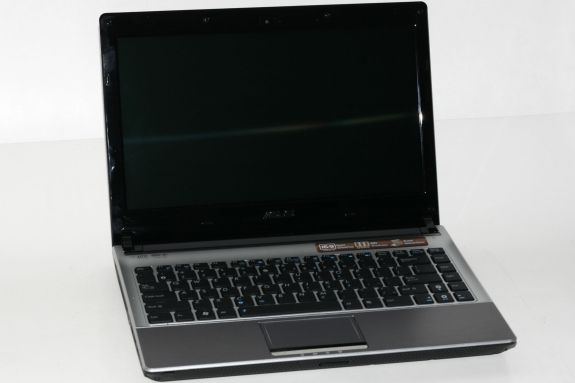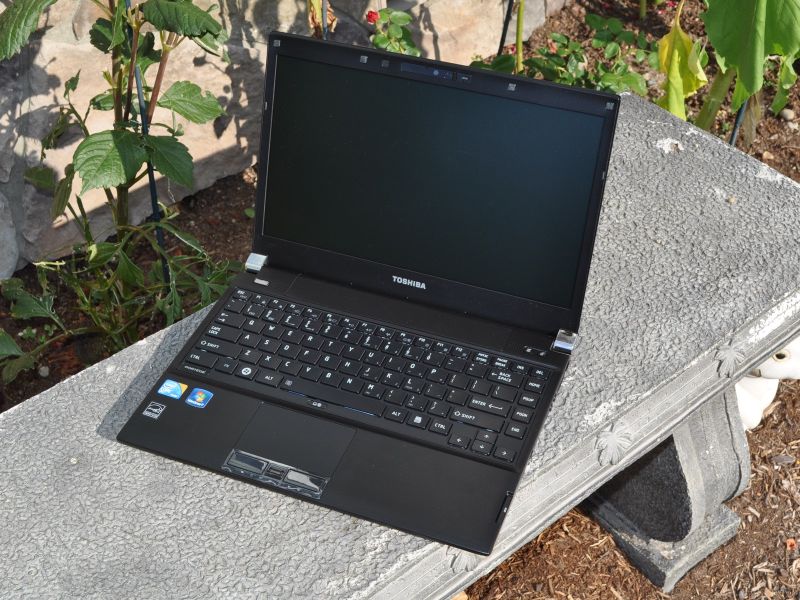Holiday Buyer's Guide: Notebooks
by Dustin Sklavos on November 15, 2010 9:00 PM EST- Posted in
- Laptops
- Guides
- Holiday 2010
Best Ultraportable: ASUS U30Jc/U35Jc ($779/$750)
The ASUS U30Jc wound up bringing home our editors' choice award when we first reviewed it, so it should come as no surprise that we'd be keen to recommend it here. It's getting a little long in the tooth, but the overall build quality and features are still worthy of recommending.

While the GeForce 310M graphics are virtually bereft of useful performance, we found the rest of the notebook to be plenty capable and able to produce exceptional battery life. In fact, it's this kind of performance and battery life that makes netbooks increasingly difficult to recommend: slightly bigger, much better machines are lasting longer on the battery.
The U35Jc variant is more or less the same machine as its slightly bigger brother, with the difference being that it eschews the integrated optical drive the U30Jc tags along. We're finding more and more these days that an optical drive just isn't the must-have kit it used to be: most operating systems can be installed via USB, and most gamers at this point are using Steam (or other similar options) to get their fix.
Either one of these notebooks is able to produce nearly eight hours of useful battery life, no mean feat for machines with dedicated graphics and mainstream (albeit low-end) Intel Core i3 processors. If they have one major flaw, it's that ASUS continues to hamstring their computers with mediocre screens, but we think the trade-off is absolutely worth it.
There's also the slightly rarefied U33Jc variant that includes USB 3.0, Intel's WiDi technology, and a bamboo shell. It's more expensive, but if you're gunning for style or think you might actually use WiDi (Vivek's in love with it), the U33Jc is an equally respectable choice.
Ultraportable Runner Up: Toshiba Portégé R700 ($945)
While Vivek was unimpressed with the blinged-out Protege R700 that Toshiba sent us for review, he submitted that the more affordable, trimmed down versions would be a lot more compelling and we certainly agree.
The Toshiba Protege brings the full line of Intel Core 2010 processors to bear in a remarkably small chassis—that's excellent mobile CPU performance in a three-pound laptop. It can't quite scrape the kinds of battery numbers we see from the ASUS U30/U33/U35 notebooks, and it doesn't have the questionable benefit of NVIDIA's low-powered dedicated graphics, but the R700 is lighter than the competition and more readily found in retail. It's also $100 more than the ASUS offerings above, so you win some and lose some.
Other Alternatives
Other alternatives certainly exist, including a lot of last-generation CULV laptops that can still get incredible battery life and cost $600 or less. We'd love to recommend the Sony VAIO Z-series as well, because it has some awesome features, but with prices starting at $1800 you need to be dedicated to the ultraportable lifestyle before making the move. Similarly, the VAIO Y-series weighs more and uses i3/i5 ULV processors, which frankly underwhelm—you can get almost the same battery life from full i3 processors running at twice the clock speed. If you can live with the "floating island" keyboard, you might even look at the Acer TimelineX laptops. Overall, though, we think the U/UL-series laptops from ASUS continue to offer the best ultraportable package without breaking the bank.











50 Comments
View All Comments
FATCamaro - Monday, November 15, 2010 - link
For most comparable system it is around 5-20% which isn't steep.Cuhulainn - Monday, November 15, 2010 - link
I'm 5'9" and weigh 168 lbs. This is in the normal weight range for body mass index.If I gained 20% more weight, I'd weigh 200 lbs and would be considered obese.
Just sayin'.
th3pwn3r - Saturday, November 20, 2010 - link
What in the world does BMI have to do with anything? Not to mention BMI is a failed investment that they won't let die. If you're judged as being obese just because you're a certain weight/height ratio it's stupid. Most body builders and fitness athletes are classified as obese through BMI.JarredWalton - Monday, November 15, 2010 - link
Well, here's steep for the MacBook Pro 15:- 2.4GHz Intel Core i5 (i5-520M or i5-450M?)
- 4GB (2x2GB) RAM
- 320GB 5400rpm Hard Drive
- SuperDrive
- NVIDIA GeForce GT 330M 256MB Graphics
- 15.4" Glossy 1440x900
- Secure Digital (SD) Card Slot
- iSight Webcam, Bluetooth 2.1+EDR
- 802.11n AirPort Extreme
- Mac OS X 10.6 Snow Leopard, 5.6 lb
Total price: $1707 online, $1800 from Apple.
I get more than that in every area with an XPS L501x, with a price of just $1000. Heck, we can toss out the Dell Precision M4500 as another comparison, which is really quite expensive since it's a mobile workstation:
Windows 7 Professional 64-bit
Core i5-520M (2.40GHz)
3 Year Basic Limited Warranty and 3 Year Next Business Day On-Site Service
NVIDIA Quadro FX 880M 1GB
2x2GB DDR3-1333MHz
15.6" HD+ (1600 x 900) Anti-Glare LED Display with Premium Panel Guarantee
320GB 7200rpm Hard Drive
8X DVD+/-RW
6-cell (60Wh) Lithium Ion Battery
Dell Wireless 1501 802.11b/g/n Half Mini Card
Dell Wireless 375 Bluetooth Module
Integrated webcam with microphone
Internal English Backlit Keyboard
Total price: $1750 (though granted that's with the current sale Dell is doing--which they do all the time)
There's no question NVIDIA charges more for Quadro 880M vs. GT 330M, though they're basically the same chip. Many of the other areas are a wash as well, but the upgraded LCD should be good (hopefully as good as the MacBook, but without testing I don't know). And of course, we're comparing 3-year warranty with on-site service to the standard 1-year Apple store warranty. This is about as close as the comparison gets.
For consumer oriented offerings, the Dell XPS and HP Envy 14 cost about half of the MacBook Pro 15 while delivering similar features. Yes, you can complain about the XPS aesthetics, but they do manage to deliver a lot for the price. So you're looking at Dell on the one hand making the XPS 15 with all the features that Apple MBP 15 has but worse aesthetics and a price of $1000. On the other, you can't actually find anything else with a decent LCD and build quality unless you move into business laptops (which not surprisingly carry a price premium), and even then Apple is priced higher for what you get.
I suppose the real question is to define "steep". 5% markup on Apple relative to Windows laptops if you include a student discount perhaps, but for average buyers the markup is at least 20%, and I'd qualify that as pretty steep considering the cutthroat nature of the computer industry.
FATCamaro - Tuesday, November 16, 2010 - link
Point taken. The XPS L501x is a winner vs the 15" MBP for value.MeesterNid - Tuesday, November 16, 2010 - link
Right, but if we really are talking mobile here then you have to consider the battery power and the weight of the machines. I'm not sure about the Dell, but the MBP is a fairly portable (not too heavy) device that gives you a fair amount of battery-powered computing time.awaken688 - Wednesday, November 17, 2010 - link
You are comparing the chips inside which is very important. But what about weight and battery.I'm still waiting to see a true side by side with the price comparison.
I still think the Apple 15 is overpriced, but some people value certain things much higher than others such a true portability (weight and battery).
Separate topic:
Long term battery test. I have 3 friends that just bought Apple laptops last year (2 MBP 15", 1 vanilla MacBook). Both are their batteries killed my PC laptop at the start. Now all 3 of their batteries can't even make it through a 1 hour meeting/class unplugged while using it.
bah12 - Wednesday, November 17, 2010 - link
Well certainly the 20% buys you some weight/battery life (hell 20% better get you something), but then subtract from those gains the hassle of OSX or Bootcamp, and the small gain is not worth it IMO. Its strictly a matter of personal opinion of course.Also all batteries degrade over time, as your experience shows Apple is not immune to this either. So replacement part cost should be a concern, and I'm sure you will see that Apple tax sneak it's way back in there too.
awaken688 - Thursday, November 18, 2010 - link
I can't comment on OSX. Most people that use Macs enjoy OS-X. I know Anand and company does. I still don't understand why someone besides the Sony Vaio Z can't produce a similar quality (speed, battery, weight, screen, usability) to a MacBook Pro. Yes I know it will be just as expensive, but we really don't even have a choice.Maybe Jared knows of one.
- 15"
- 1680x1050 Quality Matte Screen (no I don't want 1920x1080 or 1920x1200. I have a 1920x1200 Dell Precision Mobile Workstation now and that resolution is just too intense for that screen IMO)
- Core i5/i7
- 4GB+ Ram
- Decent GPU (I don't care about games. That is what consoles and desktops are for)
- Under 6 lbs.
- Less than 1" thick (although 1.1" is alright)
- Battery life under light surfing over 5 hours
I know this is a MacBook Pro basically, but is there anything out there that is like this other than Apple's offering?
8steve8 - Monday, November 15, 2010 - link
Anandtech is not entirely different, but the whole geeky media is over-obsessed with gpu performance on laptops. Very few people rely on a portable laptop for demanding 3d games, and the core i5/i3/i7 gpu is fine for non-cutting edge games like warcraft 3, and playing any sort of compressed video.Stressing gpu performance in the media forces the mfgrs to create laptops with discrete graphics, which means wasted volume, weight and energy.
case in point, even the new lenovo U260 seems to have allocated space for a gpu, in its 0.7" thick frame, and partially because of this, it can only fit a 29Whr battery.
http://shop.lenovo.com/gbweb/gb/en/learn/products/...
^ ^ you will see discrete graphics is an option... amazingly stupid trade-off on an ultra-portable.
apple stubbornly sticking to nvidia for GPU, at the cost of several years of cpu progress is not even worth a second of debate, especially on an 11" machine.
I'm not hating on anandtech, just the whole industry, reviews shape future designs, and as we are seeing now, even with good-enough-for-non-gamers igp performance, laptops of all sizes are being outfitted with discrete options. Stupid.